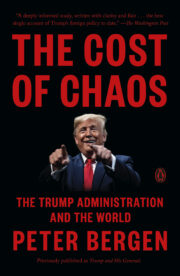Nov 18, 2001
Bin Laden: the fanatics’ fanatic Despite changing events, this is a useful guide to the world’s most wanted man, says Christopher Andrew
Copyright 2001 The Telegraph Group Limited
SUNDAY TELEGRAPH(LONDON)
November 18, 2001, Sunday
SECTION: Pg. 15
LENGTH: 906 words
HEADLINE: Bin Laden: the fanatics' fanatic Despite changing events, this is a useful guide to the world's most wanted man, says Christopher Andrew
BYLINE: By CHRISTOPHER ANDREW
BODY:
Holy War, Inc: Inside the Secret World of Osama bin Laden by Peter Bergen
Weidenfeld & Nicolson, pounds 18.99, 292 pp pounds 15.99 ( pounds 1.99 p&p) 0870 155 7222
ONLY RARELY does an author contradict his own publisher's hype as directly as Peter Bergen in his preface to Holy War, Inc. The dustjacket makes the impossible claim that this is "the complete story of bin Laden's life, career and influence". Peter Bergen, however, acknowledges that the book was not originally intended for publication until next summer.
When he delivered the manuscript to his publisher last August, he "looked forward to a civilised period of editing before its publication". Instead the volume was prepared for publication during "a furious and exhausting two weeks" after the terrorist atrocities of September 11. He asks readers to "forgive the inevitable repetitions and infelicities". Bergen's instant history of the attack on the World Trade Center and the Pentagon is, unsurprisingly, already dated. He puts that attack in context, however, by reminding us that bin Laden and his al-Qaeda network had planned to begin their "Holy War" on American soil 21 months earlier to mark the beginning of the new millennium.
In December 1999 an al-Qaeda bomber, Ahmed Ressam, was caught driving a car full of explosives into the United States from Canada. Ressam later revealed that his main target had been Los Angeles International Airport. Al-Qaeda seems to have planned a simultaneous attack on a US warship in the Middle East and American targets in Jordan.
Somewhat rough-hewn though it is, Holy War, Inc helpfully disposes of some of the bizarre myths contained in earlier studies of bin Laden. The main English-language biography of bin Laden (recently re-issued), by Yossef Bodiansky, Director of the US Congressional Task Force on Terrorism and Unconventional Warfare, contains some useful material but also claims that in 1994 bin Laden "settled" for a time in Wembley ("a notion", writes Bergen, "that Arab dissenters and journalists living in London find amusing").
Since September 11 even odder stories have surfaced, such as the allegation that bin Laden's anti-American obsession derives from an unfortunate experience with a dissatisfied US lover who complained at the diminutive size of his sexual equipment. Holy War, Inc is altogether more plausible.
Bergen also corrects the common misapprehension that bin Laden issues fatwas. In reality, while well versed in the Koran, bin Laden is not a religious scholar, has no authority to issue a fatwa on his own and depends on extremist clerics to do so on his behalf. Though not an original or even a coherent thinker, however, bin Laden has become the fanatical Pied Piper of Jihad: "His invitation to holy war resonates among disaffected and underemployed Muslim youths from Algeria to Pakistan to California." As the Pakistani leader, General Pervez Musharaf, acknowledges, "He is a hero figure on the pedestal of Muslim extremism."
Like all fanatics, bin Laden is motivated by obsessional hatreds. One of his least noticed obsessions, shrewdly observed by Peter Bergen, is with US women soldiers, whose deployment during the Gulf War he regards as the most unforgivably insulting part of "the Americans' occupation of the Arabian peninsula".
Bergen is somewhat disappointing, however, on the nature of bin Laden's racist hatred of Jews who, he believes, secretly dominate the United States. Bin Laden appears to accept as authentic the myth of the Jewish masterplan for world domination set out in the most influential and odious forgery in modern history, The Protocols of the Elders of Zion, a text fulsomely praised by Hitler in Mein Kampf which became one of the ideological inspirations for the Holocaust.
Though an interesting introduction to the subject, Peter Bergen's interpretation of bin Laden and of 21st century "Holy War" is also somewhat superficial. Not until the end of the book is there a very brief attempt to situate al-Qaeda within the longer-term context of religiously inspired terror.
During the late-20th century it became almost conventional wisdom to believe that terrorism's main objective was publicity rather than victims, to terrify rather than to kill. But this terrorism of limited aims, practised by, among others, the Provisional IRA, was simply a short-term deviation from a much more dangerous tradition of Holy Terror which is now reasserting itself. As Bruce Hoffman, the author of Inside Terrorism has shown, most terrorism, like al-Qaeda's, has been far more concerned to kill than to terrify.
Terrorists deranged enough to believe that they are doing the will of God are liable to believe that they have divine authority to massacre as many victims as they wish. Bin Laden has declared it a religious duty to obtain weapons of mass destruction for use against the United States and the Jews. As Peter Bergen reminds us, he began experimenting several years ago in the use of cyanide gas, the weapon used in the Nazi "Final Solution", which he planned (and may still plan) to put into the air-conditioning systems of US government buildings.
The question, alas, is not whether the terrorists of the 21st-century will use weapons of mass destruction but when and where they will do so.
Christopher Andrew's most recent book, with Vasili Mitrokhin, is 'The Mitrokhin Archive: The KGB in Europe and the West' (Penguin).
MORE ARTICLES 
FEATURED BOOK

